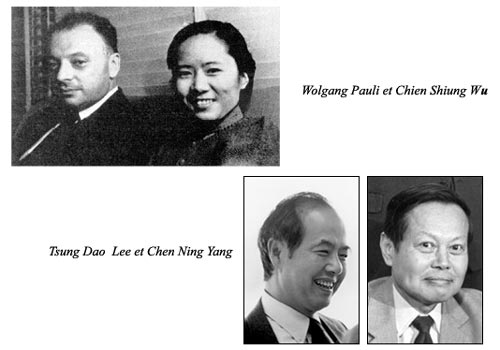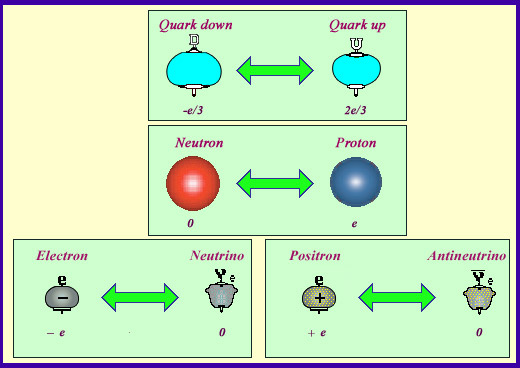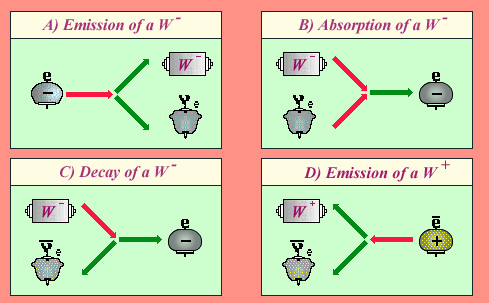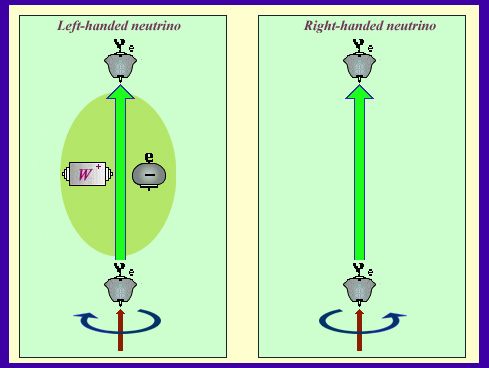A special and fascinating fundamental interaction
A third force is at work in the nucleus next to the nuclear attraction that binds the nucleus and Coulomb repulsion forces. This quiet strength, whose intensity is much less important than the other two, is called « weak interaction or weak force. »

A discovery : the violation of « parity »
These photos shows the actors of the discovery of parity violation in weak interactions in 1956. This was first predicted by two young Chinese theorists, TD Lee and CN Yang. They introduce the idea that weak interaction might not verify one of the fundamental symmetries of physics. This prediction was verified a few months later in an experiment on beta decay of cobalt-60, by Madame Wu : a nucleus of Cobalt and its mirror image disintegrated differently. Wolfgang Pauli, the neutrinos father, who can be seen with the young experimenter, said that « God was a little left-handed. » Lee and Yang were awarded with the Nobel Prize in Physics barely a year later, in 1957.
© DR
Beta radioactivity is the best known manifestation of the weak force. It’s a slow process as it occurs with difficulty. Unlike nuclear forces and electromagnetism, the weak force can transform a neutron into a proton or vice versa, thus changing the composition of a nucleus. The hallmark of this transformation is the emission of an electron (or positron), with an undetectable antineutrino (or neutrino) .

A « transforming » interaction …
Nature uses the weak interaction as a tool when it needs to transform matter. The weak interaction associates particles in pairs: for example, neutron with proton, down quarks with up, electron with a neutrino, positron with an antineutrino. In each of these « doublets », the electric charge of the two particles differ by one unit. It is by changing its electrical charge and thus its nature, that the weak interaction converts a member of the doublet into another.
© IN2P3
For physicists, the weak interaction is an interesting, remarkable and uncommon interaction. For example, elementary particles like quarks, electrons or neutrinos behave like tiny spinning tops that rotate on the left or on the right. While other interactions are unable to distinguish these two directions of rotation, the weak interaction favours « left » rotations. It breaks one of the fundamental symmetries of space. In the case of neutrinos, this symmetry breaking is the most spectacular.
It is in 1956, that was highlighted by two American physicists of Chinese origin, Lee and Yang, this asymmetry of the weak interaction in beta decay of cobalt-60. Physicists call this assymetry Parity Violation.

Couplings and W boson
The example of the electron-neutrino pair shows how the weak interaction changes a particle nature, by emitting an intermediate particle called W boson. This boson carries a positive or negative elementary charge (NB: The red arrows refer to initial particles, the green to those in the final state). In (A), an electron loses its electric charge by emitting a W boson and becomes a neutrino; (B) represents the reverse reaction, the capture of the W boson by a neutrino; in (C), the disintegration of a W-minus is obtained from (B) by replacing the incoming neutrino, with an outgoing antineutrino. In the fourth diagram (D), the emission of a W-plus boson by a positron, is obtained from (C) applying the same rule.
© IN2P3
Despite its discretion, the weak force plays a fundamental role in the universe. Without it, for example, the sun would not work because it would be unable to convert hydrogen into deuterium. We also believe that the absence of antimatter in our environment, to whom we owe the existence of the universe, is due to the weak interaction. There are other manifestations of the weak force, but beyond the scope of radioactivity. The origin of this force is now well understood. Its mechanism is similar to electric and magnetic forces.

An Asymmetric interaction …
Neutrinos are particles that travel at the speed of light and are only sensitive to the weak force. In principle they exist under two states of spin around the axis defined by their direction of propagation. These two states are called left and right neutrino and they behave very differently. While the first becomes temporarily a W boson and an electron under the effect of the weak interaction, this transition is forbidden for the second to the point that it can not interact or be produced. Similar asymmetries are observed with electrons, quarks and nucleons, however less important. Physicists are used to say that the weak interaction « violates parity ».
© IN2P3
We owe to three physicists Sheldon Glashow, Abdul Salam and Steven Weinberg, a theory unifying the electromagnetic and weak forces (1972). This theory was confirmed in 1982-83 by the discovery of the very heavy particles, called the W and Z bosons, responsibles for this force.
Other articles on the subject « Radioactive nuclei »
Map of Nuclei
Map of stable and unstable nuclei The progress made in our understanding of the subatomic world o[...]
Stability Valley
Beta decay : nuclei getting slimmer to achieve stability The nucleus mass is related to its inter[...]
Nuclear Forces
Three nuclear forces and their hierarchy Three types of force act alongside each other inside a n[...]
Mecanisms of Radioactivity
The way radioactivity works and its origins The impressive range of half-lives that exist, extend[...]
α decay : tunnel effect
Particle and wave: an effect of quantum mechanics The great age of uranium and thorium nuclei tha[...]
Alphas with gammas
Gamma rarely accompanies alpha decays It is surprising that one can hold with hands a sample of p[...]
β decay : weak forces
The forces which allow a nucleus to emit beta electrons Beta decay (β) and electronic capture cha[...]
The Nucleosynthesis
Primordial and stellar nucleosynthesis The Universe hasn’t always existed, It was born a li[...]
Nucleosynthesis (continued)
Mechanisms of atomic nuclei formation Most of the nuclei of atoms that make up our daily life wer[...]